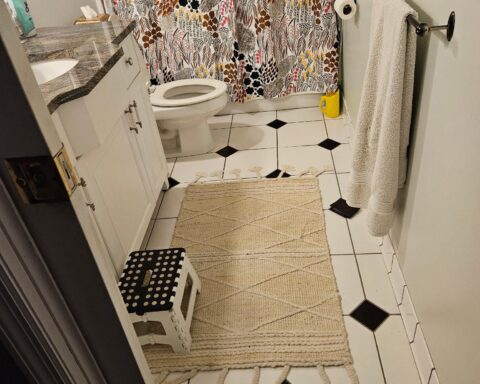Estimating the cigarette market
To arrive at an estimate of the relative size of the illicit cigarette market in the country, we first calculated unit prices of an individual cigarette stick by dividing the self-reported amount spent on the last purchase by the number of cigarettes bought. This was multiplied by 20 to get a standardised price for a pack of 20 cigarettes, the most common pack size. The number of cigarettes smoked per day was then multiplied by 365 (for daily smokers) and the number of cigarettes smoked per week by 52 (for some-day smokers) to obtain annual cigarette consumption. Dividing this amount by 20 gave the number of cigarette packs consumed by a smoker per year. The sum of these across all smokers constitutes the total cigarette market volume in packs for the sample.
Finally, the volume of the illicit cigarette market is obtained by restricting the sample to the smokers whose reported unit price per pack is below the threshold price. Dividing the volume of illicit cigarettes by the total volume of the cigarette market gives the illicit market share.
About 12.1% of the price observations had to be dropped, because it was not possible to determine whether the reported price was for a pack of 20, a pack of 10 or a single cigarette stick. For the price analysis, therefore, the sample was restricted to only those observations that clearly captured the price of a single stick or a pack of 20.
Results
Table 1 presents the main demographic and socioeconomic characteristics of the respondents. As expected, most smokers interviewed were male (90.2%). A larger proportion of smokers resided in urban areas (54.4%), were married (72.7%) and between the ages of 25 and 54 years (69.4%). Most respondents came from Brikama (33.9%), the largest of the LGAs, while the lowest number of respondents (3.1%) was from the capital, Banjul. According to the 2013 census, Brikama accounted for 37.2% of the total population and Banjul accounted for only 1.7%.11.
Sample’s description
In terms of educational attainment, most respondents (41.4%) reported having no schooling, 17.9% had some primary schooling and about a third (33.6%) had completed at least secondary school (about 7% did not provide information on education). In comparison, the Gambia Youth Report of 2013, which includes both smokers and non-smokers, found that about 32% of the youth had never been to school, 16% had attended only primary education and 47% had some level of secondary education.1 The discrepancies with our sample are due to the fact that the Youth Report of 2013 restricted the population to those between the ages of 13 and 30 years, while our sample focused on the adult smokers aged 18 years and above.
In terms of smoking behaviour, over 70.8% of tobacco users smoke cigarettes, 14.4% use roll-your-own (RYO) and 6.9% use other types of tobacco. This is similar to findings from the 2013 Demographic and Health Survey (DHS).12 Further, approximately 64.5% of all cigarette smokers reported buying single cigarette sticks compared with 8.1% who are purchasing a cigarette pack, the rest are missing. The analysis focuses only on those consuming manufactured cigarettes (table 2).
Most (95.7%) cigarette smokers bought their cigarettes from a shop or store rather than from street vendors. Daily smoking intensity was estimated at 10.7 cigarettes smoked per day. This is quite similar to the 2013 DHS, which found that over 50% of cigarette smokers had smoked 10 or more cigarettes during the 24 hours preceding the survey.12
The three most frequently purchased cigarette brands were Piccadilly, Bond Street and Royal Business. Combined, these three brands account for 80% of all purchases. The remaining brand preferences are: Monte Carlo (10%), Benson & Hedges (B&H; 3.4%) and Sir (2.7%). The most expensive brand was B&H at GMD71.72 (US$1.51) per pack of 20, followed by Bond Street at GMD58.32 (US$1.22) and Piccadilly at GMD57.18 (US$1.20). The cheapest cigarette brand was Sir at GMD38.61 (US$0.81) (see table 2).
In terms of illicit cigarette purchases, the survey found that approximately 7.3% of smokers may have recently purchased an illicit cigarette, based on the self-reported amount spent on the last purchase. However, when smoking intensity is considered, the market share of illegal cigarettes in the Gambia increases to 8.6% of the total market. This means that those evading cigarette taxes are heavier smokers. The estimate based on cigarette pack features is markedly different: only 0.9% of the packs examined were found without the requisite labels for a legal cigarette pack (see table 3). The brands identified without these labels were Piccadilly (one pack) and Monte Carlo (two packs).
We found statistically significant differences in pack possession across geographical areas, but also due to education (smokers with no schooling were less likely to have a pack), place of purchase (smokers buying at street vendors were less likely to have a pack) and smoking frequency (daily smokers were more likely to have a pack compared with occasional smokers). table 2 in online supplementary material 1.
A sensitivity analysis conducted on the price threshold indicated more robustness moving downwards than it did moving upwards. We found the proportion of illicit cigarettes unchanged after varying the price threshold downwards by both 5% and 10%, while it reduced to 7.9% when the price threshold was lowered by 15%. In contrast, the proportion of illicit cigarettes remains unchanged when the price threshold was raised 5% but jumped to 10.9% and 11.0% when the price threshold was raised 10% and 15%, respectively. Further excluding occasional smokers from the sample does not change the estimate of the illicit market.
We compare the proportion of legal and illicit cigarettes disaggregated by sociodemographic characteristic and other variables in table 4. We found that those who were divorced, widowed or separated, older smokers, those with higher income and those buying from street vendors were more likely to use illicit cigarette.
Proportion of illicit cigarettes by sociodemographic characteristics
Among illicit cigarettes determined using only the price threshold, Piccadilly accounted for 32.7% of illicit cigarettes, Monte Carlo for 13.5%, while Force 10 and Royal Business accounted for 11.5% each. Bond Street and Sir accounted for 9.6% of the illicit market each while D&J accounted for 7.7% of the illicit market (see figure 1). The lowest share of illicit cigarettes was held by the brands Ransom and B&H, which each accounted for 1.9%.
Given that the overall market shares of Piccadilly (32.6%) and Monte Carlo (10%) are close to their illicit market shares, these brands seem to be supplied almost evenly via both channels. On the other hand, the overall market share of Royal Business (24.5%) is much higher compared with its illicit market share, meaning that this brand is primarily supplied legally. Brand Force 10 seems to be supplied almost exclusively via illegal channels.
Tobacco control




